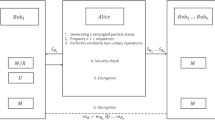Abstract
We outline a straightforward approach for obtaining a secret key rate using only no-signaling constraints and linear programming. Assuming an individual attack, we consider all possible joint probabilities. Initially, we study only the case where Eve has binary outcomes, and we impose constraints due to the no-signaling principle and given measurement outcomes. Within the remaining space of joint probabilities, by using linear programming, we get bound on the probability of Eve correctly guessing Bob’s bit. We then make use of an inequality that relates this guessing probability to the mutual information between Bob and a more general Eve, who is not binary-restricted. Putting our computed bound together with the Csiszár–Körner formula, we obtain a positive key generation rate. The optimal value of this rate agrees with known results, but was calculated in a more straightforward way, offering the potential of generalization to different scenarios.

Similar content being viewed by others
References
Bohm, D., Hiley, B.: The Undivided Universe. Routledge, London (1993). introduced in Ref. [2]
Bell, J.S.: Speakable and Unspeakable in Quantum Mechanics. Cambridge University Press, Cambridge (1987)
Bell, J.S.: Physics 1, 195 (1964). reprinted in Ref. [2]
Nielsen, M.A., Chuang, I.L.: Quantum Computation and Quantum Information. Cambridge Univ. Press, Cambridge (2000)
Barrett, J., Hardy, L., Kent, A.: No signaling and quantum key distribution. Phys. Rev. Lett. 95, 010503 (2005)
Acín, A., Gisin, N., Masanes, L.: From Bell’s theorem to secure quantum key distribution. Phys. Rev. Lett. 97, 010503 (2006)
Acín, A., Massar, S., Pironio, S.: Efficient quantum key distribution secure against no-signalling eavesdroppers. New J. Phys. 8, 126 (2006)
Bennett, C.H., Brassard, G.: Proceedings of the IEEE International Conference on Computers, Systems, and Signal Processing, Bangalore, p. 175. IEEE, New York (1984)
Huttner, B., Imoto, N., Gisin, N., Mor, T.: Quantum cryptography with coherent states. Phys. Rev. A 51, 1863 (1995)
Mishra, M.K., et al.: Bipartite coherent-state quantum key distribution with strong reference pulse. Quantum Inf. Process. 12, 907 (2013)
Barrett, J., Linden, N., Massar, S., Pironio, S., Popescu, S., Roberts, D.: Nonlocal correlations as an information-theoretic resource. Phys. Rev. A 71, 022101 (2005)
Jones, N.S., Masanes, L.: Interconversion of nonlocal correlations. Phys. Rev. A 72, 052312 (2005)
Pawlowski, M.: Security proof for cryptographic protocols based only on the monogamy of Bell’s inequality violations. Phys. Rev. A 85, 046302 (2012)
Hwang, W.-Y., Gittsovich, O.: Security proof for cryptographic protocols based only on the monogamy of Bell’s inequality violations. Phys. Rev. A 85, 046301 (2012)
With respect to physical implementation, the protocol is almost the same as the Ekert protocol [16]. However, because security is analyzed with a different, though related, point of view, we give a new name
Pironio, S., Bancal, J.-D., Scarani, V.: Extremal correlations of the tripartite no-signaling polytope. J. Phys. A Math. Theor. 44, 065303 (2011)
Csiszár, I., Körner, J.: Broadcast channels with confidential messages. IEEE Trans. Inf. Theory 24, 339 (1978)
Gass, S.: Linear Programming: Methods And Applications. Dover Publications, Mineola (2010)
Acknowledgments
This study was supported by Basic Science Research Program through the National Research Foundation of Korea (NRF) funded by the Ministry of Education, Science and Technology (2010-0007208), and by National Research Foundation and Ministry of Education, Singapore, and the people programme (Marie Curie Actions) of the European Union’s Seventh Framework Programme (FP7/2007-2013) under REA grant agreement N.609305. NK acknowledges the Ontario Graduate Scholarship program for support.
Author information
Authors and Affiliations
Corresponding author
Rights and permissions
About this article
Cite this article
Hwang, WY., Bae, J. & Killoran, N. No-signaling quantum key distribution: solution by linear programming. Quantum Inf Process 14, 687–696 (2015). https://doi.org/10.1007/s11128-014-0880-1
Received:
Accepted:
Published:
Issue Date:
DOI: https://doi.org/10.1007/s11128-014-0880-1




